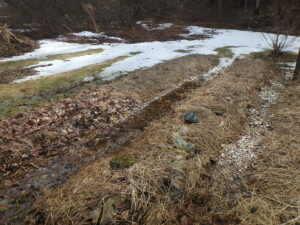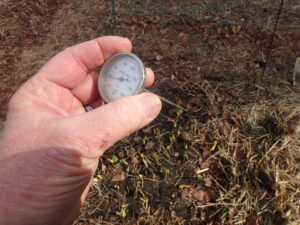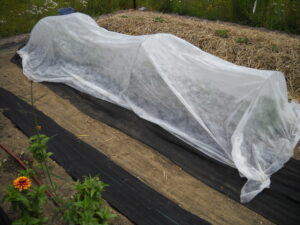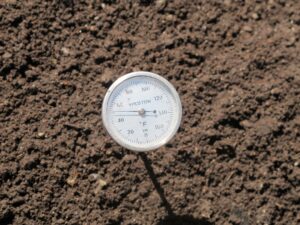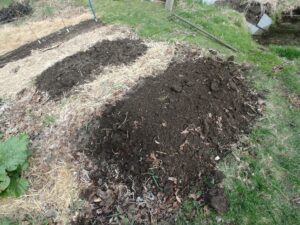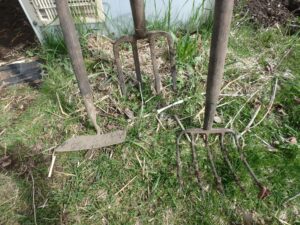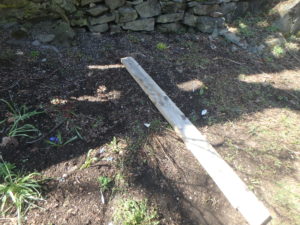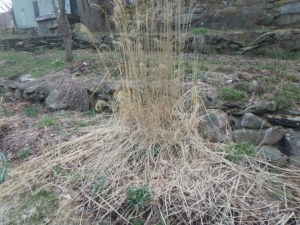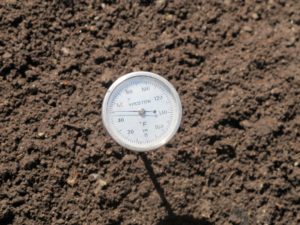Vegetables: When Is It Time to Plant?
The internet has many guides and suggestions for when you should plant, but I think an experienced next door neighbor probably has a better sense of when to plant. So, for example, one internet source says the last frost for Cornish Flat, NH is May 15, while another internet sources says June 11 to 20. That’s over a month of difference! But perhaps an old timer in your town can advise you, depending on your exact location.
Soil temperature is important, too. Seeds are genetically programmed not to germinate if the soil is too cold. That makes sense: seedlings are tender and many can be damaged by frost. So you can plant spinach or peas seeds “as early as you can work the soil”, according the package, but they may not germinate for weeks if the soil is cold – and they may rot.
You can protect seedlings from light frost by covering them with something called row cover, Reemay, or Agribon. These are spun agricultural fabrics that come in 5 foot wide swaths that you can cut to fit your rows. Unlike plastic sheeting, this stuff breathes and allows moisture to pass through it. Buy the wires sold to support it and form hoops over your plants. It will also keep bugs off your plants, but you need to remove it when vine crops start to bloom – they are insect pollinated.
Is It Time to Plant Yet?
What I have found is that soil temperature is very important to success. Yes, you can plant peas or spinach “as soon as the soil can be worked” (as described on the packages), but those seeds won’t germinate and grow if the soil is in the forties. And the seeds can rot. Seeds have triggers that tell them when to grow. That’s why starting seedlings indoors on heat mats speeds things up. The seeds think it is summer when the soil is 72 degrees. Generally the soil must be 60 degrees to get a good quick germination.
Another advantage of warming the soil with plastic for a few days is this: you can cook and kill annual weeds. They are sensitive to high temperatures when they first come up. Dandelions or witch grass, which are perennial, have root systems you know and hate. A few hot days under plastic will only make them giggle.
So how do I prepare my garden? I create wide, raised beds using only hand tools. I have a 5-tined potato fork or hoe that has been in my family for 50 years or more. I use it to loosen the soil and shape the beds. But you can use an ordinary garden fork and a hoe to accomplish the same. I pull up soil from the walkways to raise the level of the beds and shape them. I try to disturb the soil as little as possible.
Most of my raised beds are between 24 and 36 inches wide and are 6 to 8 inches above the walkways, which I keep narrow, so as to not waste space. Generally they have no wood sides, though I do use planks to contain the soil in a few. I like a wood-sided raised bed for growing carrots, as they need fluffy soil with no rocks in order to get to be 12 inches long, my goal each year. With wood-sided beds you can build whatever soil you want by mixing in the ingredients.
Early Spring Chores
The snow is gone, and I am ready for gardening. And although I have been able to do a few things in the garden, the soil is wet and easily compacted, so I can’t do much until it dries out.
Many of my flower beds are six feet or more deep (from front to back). This means I can’t stand on the lawn and reach to the back to remove leaves or sticks. I don’t want to walk into the beds and risk compacting the soil. Plants get their oxygen through their roots, and compacted soil has little space for air. The solution? I place a plank on the soil and walk on that. It spreads out my weight.
I generally advise gardeners to wait until the lawn gets green before raking out the sand and dirt that was dumped by the snowplows. I say this because dormant grass is easily pulled up by vigorous raking. But this year I had a lot of sand, and I feared the mess would choke out large sections of lawn near the road. So I used a plastic rake, and raked gently, and I was able to clean up with very little damage to the lawn.
Other chores? If you have decorative grasses in your perennial border, it is important to cut back last year’s stems now, before new growth occurs. I don’t cut back decorative grasses in the fall: I like to see them standing up in the snow, waving in the winter wind.
I have a big clump of tall maiden grass, Miscanthus sinensis, a variety called ‘Morning Light’. Last year it had started growing before I got around to cutting it back, and there was no way to remove the bottom 8 inches of dead grass, which was unsightly. This year I cut it back low to the ground early and won’t have that problem. Hand pruners work best for cutting back the stems.
The moles and voles always make a mess of the lawn, digging up soil and leaving lumps and squiggles of soil they displaced in winter. I’ve been cleaning that up now, too. I have an aluminum grain scoop/shovel that is 14 inches across and very lightweight. I use a short-tined rock rake to dislodge the lumps and get them onto my shovel. I consider this soil a gift from the rodents. It is good soil that I use to fill holes and top-up raised beds that need some added topsoil.
Although I know people have already started their peas and spinach, my soil is awfully cold for them. Yes, you can plant the seeds when the soil is 50 degrees F, but waiting until it is 60 degrees makes sense to me. Seeds germinate much more quickly in warmer soil, so there is less chance of the seeds rotting.
A soil thermometer is not an expensive item and will last a lifetime. I have a few, and they all have dials like old-fashioned oven thermometers. The sensor is right on the tip. Keep that in mind when checking soil temperatures. If you push the tip down 6 inches, the soil will be cold at this time of year – but you are not planting seeds that deep. Instead measure the soil temperature an inch down, which means holding the thermometer upright for a couple of minutes while it adjusts. Otherwise it will fall over – hence the impulse to push it down deep.
Near the end of April I moved my cold frame out of the barn and into the garden. This is a cedar box with polycarbonate lids that allow sunshine into the box, and hold heat in. The polycarbonate helps diffuse the light, reducing chances of cooking the plants. The lids are on a slant, and open on hinges.
After a couple of sunny days the soil inside the box had warmed up, and I planted seeds of lettuce, kale and carrots inside. Once they sprout, I’ll lift the lids a little each sunny day to allow air circulation and to moderate temperatures. The box itself is 8 feet long and 2 feet across. I got mine from Gardeners Supply (www.gardeners.com or 888-833-1412).
Meanwhile, indoors, I have 5 flats of seedlings growing under lights. These require daily attention, though not much. I water, and I pluck out or snip off extra seedlings that grow. I want just one tomato plant per cell, for example, though I always plant 2 per cell just to be sure that I get one to grow. It’s hard to kill a cute little tomato plant, but I know that the survivor will do better if it’s not competing for water and nutrients.
Other early plants I have started include lettuce, kale, purple cauliflower, 3 kinds of flowers and Happy Rich. Happy Rich is a non-heading broccoli I get from Johnny’s Seeds. It produces the equivalent of side shoots on regular broccoli, but it is quicker to produce, and keeps on cranking out its green blossoms well into the fall. The part we eat is really the buds of its flowers. I have never seen Happy Rich seedlings for sale in a nursery, so I start my own each year.
Another recent chore involved taking the straw mulch off my strawberry plants. Once the plants and the new plants started by runners are awake and growing, I’ll cut any runners connected to the mother plant.
There will still be frosty nights here, and raw rainy days. But I know the worst is over, and summer is just around the corner.
Read Henry’s blog posts at https://dailyuv.com/



